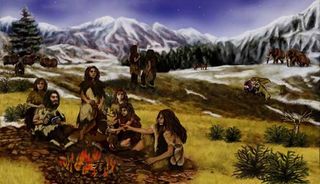Different Tastes: How Our Human Ancestors' Diets Evolved

Our human ancestors began tasting food differently sometime after the human family tree branched off from the ancestors of chimpanzees, researchers say.
By analyzing the genes of Neanderthals and other extinct human ancestors, scientists also found that modern humans may be much better at digesting starch than any other known member of the human family tree.
Although modern humans are the world's only surviving human lineage, other human lineages also once dwelled on Earth. These included Neanderthals, the closest extinct relatives to modern humans and Denisovans, whose genetic footprint apparently extended across Asia. Both Neanderthals and Denisovans descended from a group that split from the ancestors of all modern humans, although modern humans remain more closely related to these extinct human lineages than to chimpanzees. [Image Gallery: Our Closest Human Ancestor]
Much remains uncertain about the extinct relatives of modern humans. Uncovering more details about the way they lived, such as what they ate, could shed light on the evolution of the human lineage overall, including modern humans.
Different tastes
Scientists recently sequenced the genomes of a Neanderthal woman from a cave in Siberia and a Denisovan girl from the same cave. This revealed that both Neanderthals and Denisovans once interbred with the ancestors of modern humans.
To learn more about the lives of Neanderthals and Denisovans, researchers investigated genes that prior studies linked to the activity of eating in modern humans. Changes in diet such as cooking food and domesticating plants and animals are thought to have played major roles in the evolution of hominins — the group consisting of humans and their relatives after they split from the chimpanzee lineage — such as increases in brain size.
Sign up for the Live Science daily newsletter now
Get the world’s most fascinating discoveries delivered straight to your inbox.
A key area of interest for the scientists were genes for taste receptors, which are molecules on taste buds that help people taste flavors. They found that the genes for two bitter taste receptors, TAS2R62 and TAS2R64, mutated in hominins after the ancestors of chimpanzees and hominins diverged, making the hominin versions inoperative. They found that this mutation occurred before the split between the ancestors of modern humans — Neanderthals and Denisovans. It remains uncertain what specific bitter molecules these receptors target, but they may be substances that are common in the diets of most or all great apes, but that are rare or absent from hominin diets. [The 10 Biggest Mysteries of the First Humans]
"Since we know these mutations are specific to the human lineage, perhaps we can learn something about human evolution by figuring out what substances the functional versions of these receptors are responsible for tasting," said lead study author George Perry, an anthropological geneticist at Pennsylvania State University in University Park.
The investigators also found that in the Neanderthal they studied, a mutation deactivated a gene for another bitter taste receptor, TAS2R38. This receptor helps detect a compound known as PTC, which is regularly used to measure sensitivity to bitterness.
The Neanderthal woman the researchers investigated had two copies of the gene for TAS2R38 — one from her father, the other from her mother. Although a mutation deactivated one of these copies, the other apparently remained functional. This suggests that, like chimps and modern humans, Neanderthals may have experienced variable levels of sensitivity to PTC.
"It's hard to say what that means, because we don't necessarily know what natural substances go along with this particular taste receptor in the wild," Perry told Live Science. "Maybe this taste receptor was important for being able to taste something bad for you, and if this food went away due to a change in the environments of humans, Neanderthals and chimpanzees, there was less pressure to maintain the functional version of this gene in all three lineages."
Window into the past
In addition, the scientists discovered that mutations deactivated the gene MYH16, which is linked to jaw muscles, after the ancestors of chimpanzees and hominins diverged, but before the ancestors of modern humans split from those of Neanderthals and Denisovans. This may explain why modern and extinct human lineages have relatively weak jaw muscles compared with ape relatives such as chimpanzees. The researchers suggested that this gene loss may have occurred after the development of cooking, which can make food easier to eat, lessening the need for stronger jaw muscles.
"Gene loss is a very interesting and potentially powerful window to our evolutionary history, because there's some change in our behavior or environment that likely precipitated that gene loss — the removal of some constraint," Perry said.
Moreover, the researchers discovered that compared with the Neanderthal and Denisovan genomes, the modern human genome on average possesses three times more copies of AMY1, the gene for salivary amylase, which is an enzyme in saliva that helps break down starch. These modern human gene duplications apparently occurred in the last 600,000 years, after the split between Neanderthals and Denisovans.
Prior research suggested that early hominins may have eaten large amounts of starchy foods, such as roots and tubers. This new finding regarding AMY1 suggests that if early hominins did eat lots of starch, they may have been less efficient at doing so than modern humans.
As for what these findings suggest about the fad known as the paleo diet, Perry said that "these findings show that we're complex combinations of ancient adaptations and more recent adaptations to changing diets. To try and pick a single point in time and try to adapt to the diet of that particular time doesn't reflect our complexity."
In the future, analysis of more Neanderthal and Denisovan genomes could yield further insights into the evolutionary history of the human diet, Perry said.
The scientists detailed their findings online Jan. 3 in the Journal of Human Evolution.
Follow us @livescience, Facebook & Google+. Original article on Live Science.

Most Popular


